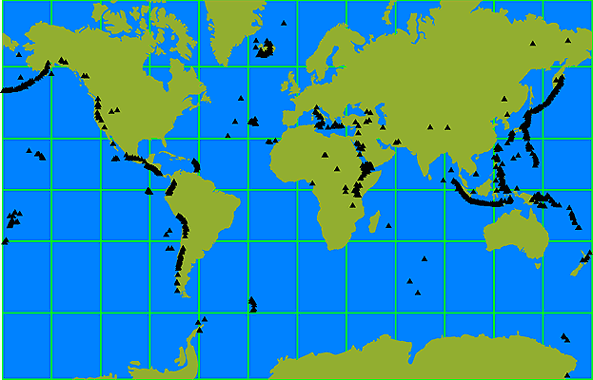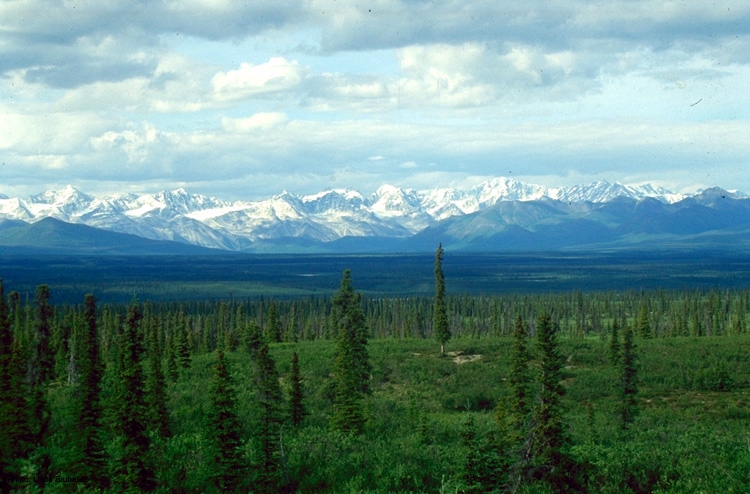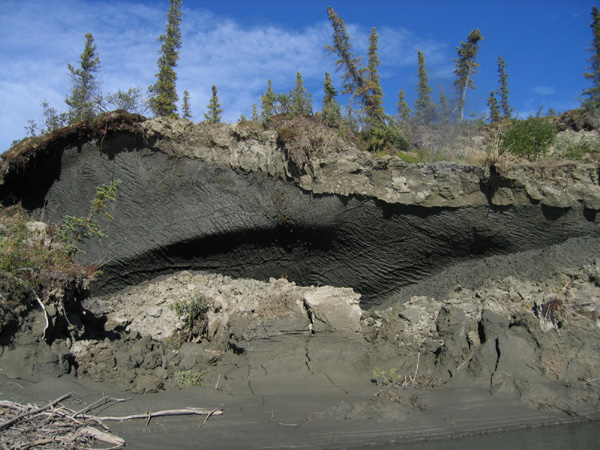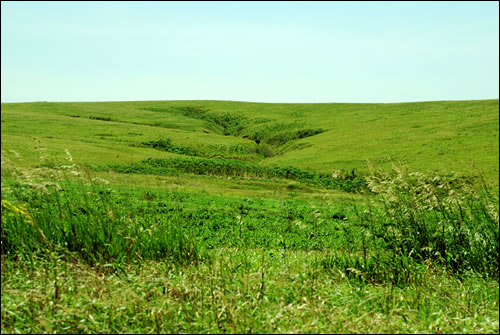Biomes
Tundras
Tundras are those cold, cold regions that form either at the very top of the world near the poles, at the poles themselves, or around mountains that have extremely high altitudes.
Arctic tundras most likely are the tundras most people are familiar with. Think of northern Canada and Alaska or Greenland. An arctic tundra is noted for its low percipitation and low temperatures, giving rise to relatively short growing periods. Trees are non-existent in arctic tundras and instead low plants such as mosses, shrubs, and rushes compose most of the plant life, though taller shrubs can form.
Permafrost is the driving force behind the formation of an arctic tundra as it forces all water to remain above it and will never ever thaw short of the Sun smashing into the earth or Superman using his laser eyes to burn a hole in it. By forcing the water to remain above it the permafrost leads to an environment which is relatively wet, definitely wet enough to sustain some form of life, but at the same time soil is thin and it is difficult for any large plants to take root. When seasons change and winter takes a firm hold the plant life barely remains and in areas at higher elevations the plants can be easily stripped away to reveal bare, icy rock. In areas where there is no plant life at all the seasonal changes can result in the entire landscape changing as periods of thawing and refreezing occurs.
Alpine tundra is found only at very high elevations around very tall mountain ranges and they differ greatly from an arctic tundra climate. For one they do not lend themselves to the development of thick layers of permafrost, creating a drier environment. For another they are constantly exposed to harsh winds that can easily rip plants from the ground or rob them of precious heat and energy.
This leads to plant life in alpine tundras being very short so as to not be as easily picked up by the strong winds or robbed of heat and energy. Plant life in alpine tundra are sheet-like in that they blanket the landscape and are very low to the ground and because of this curious nature the air underneath these plant-sheets can be 60°F warmer than above it.
We have to also remember that great mountain ranges can form in tropical areas and this tropical surrounding influences the nature of the alpine tundra. In the tropics an alpine tundra has more seasonal variation in rainfall, though the average seasonal temperature remains relatively the same. It is during the day and night that the temperatures fluctuate wildly: at nights it can drop below freezing while during the day you can almost swear it is summer (a tundra's summer, but summer none the less!) And because cold is not linked to seasonal changes plants have the ability to grow taller without the fear of losing much needed heat and energy. These plants are almost tree-like in nature and are able to resist the deadly cold of the night by retaining dead leaves close to their stem as a form of insulation and generally the higher you go in a tropical alpine tundra the larger these plants are.
As for animals in a tundra it can be said across the board that they are extremely hardy and more than able to survive such awful conditions. During the winter they are not as active, but during the summer the tundras teem with life. Insects are very common- surprisingly enough- due to the low plants isolating the ground from too much cold weather, creating an adequate microclimate!
Taiga (Boreal Forests)
Would you believe that on earth Taiga is the largest kind of vegetation? It takes up about 11% of the surface and is made up of four 'zones': the very northern tip that is not all that different from tundras, save for the fact that it has trees in the form of stunted spruces with a lot of lichen and moss in between; the belt beneath this which is more of a forest, but not quite as it still is only made up of slightly less stunted spruces, though there is less moss and lichen and more tree lifeforms; the 'main' belt that is a great big forest of pines and spruces with the occasional birch and poplar; and the last zone that is a mix of the cold-climate spruces, birches, and pines with more temperate trees found in the latitudes south of the Taiga belt.
To be precise Taiga refers to the northern and barren range while Boreal Forest refers to the southern and fertile (for a really cold area) range.
Season are more grounded in taiga than in the tundra: summers are warm and moist, but short while winters are long, dry, and cold with snows lasting well into spring. Though not as extreme as a tundra, the temperature fluctuation during the winter can still be up to 200°F.
Permafrost also still exists in taiga due to the thick canopy of trees keeping enough sunlight out for the thick layer of ice to form, the lack of light created by this canopy also kills off the little sheet-shrubs that are common in the tundra. Instead carpets of moss and lichen cover the ground and acts as an insulator for the permafrost, meaning that when it is colder the permafrost will move to the surface and reduce the amount of soil available and when it is warmer it recedes, though a tree's root will still be covered by the permafrost and lose water through its leaves so that they die, giving rise to the term 'winter kill'.
Wildfires are common in taiga, but unlike the danger it presents in southern biomes wildfires act as a rebirth effect in the boreal forests. The taiga trees are very resistant to fire so that during drought-periods when fires are common they will not be consumed by the flames unless it is very severe. Instead the fire will gobble up the lichen and moss carpets and create a fertile bed for new trees to be formed.
Speaking of gobbling up the plants animals are much more present in the taiga, though they share a bond with the tundra. Many animals, like the herds of Caribou, will exist in the tundras during the summer where they will feast to their heart's content on the low-lying shrubbery, but when fierce winter comes they retreat into the taiga forests to eat the lichen and moss carpets. The lichen feeds all manner of deer and the trees attract squirrels, birds, and beavers, who in turn attract wolves, pine martens, and lynx to name a few. Basically the taiga is still an unfriendly environment, but much more welcoming to animal life than the tundra.
Grasslands
Prairie, savanna, and steppe are the three primary grasslands and the major difference between the three is temperature. Temperate climates produce steppes and prairies, while tropical climates create savannas. Prairies and savannas also share a similarity in the amount of percipitation per year which is very little- only enough to make it not a desert; savannas on the other hand receive a great deal more rain, but generally the rain comes in long periodic times during the year rather than being spaced out evenly. All three biomes have a tendency to have high rates of evaporation and droughts are far from uncommon.
Steppes are the coldest of the three primary grasslands and their winters are cold seasons just barely above freezing. The vegetation is rather similar to a tundra's in that the plants are low to the ground, except tussok grasses ('bunch grass,' or grass that grows in little clusters rather than sheet-like) dominate the landscape.
Prairies come in three varieties, tall grass, mixed grass, and short grass, and grow in warmer climates opposed to a steppe's cold climate. Tall grass prairies are produced by the grass being able to 'beat' the forests that could potentially grow in the area (the conditions are right for forests to be grown in areas where tall grass prairies are present) through better adaption or due to some catastrophic wildfire clearing trees from that area and leaving behind fertile soil for the grasses to take root. Still, forests tend to be near by to any tall grass prairie and given enough time the forest can overtake the grassland.
Mixed grass prairies are like the buffer zones between the short and tall grass prairies and the dominance of one grass over the other is dependent entirely upon rainfall- which definitely will vary from year to year. They contain both short and tall grasses and have no distinct grasses of their own, instead acting as a mixing ground as the name suggests.
Infrequent or otherwise light rainfall produces short grass prairies which emphasize grasses which do not penetrate deeply into the soil- as there is little moisture in the soil. Sod, or turf, is also very frequent in the short grass prairies.
Savannas are an entirely different kind of grassland on their own due to the great amounts of rainfall they enjoy when compared to the relatively sparse percipitation in the temperate prairie and steppe. Taller grasses are common in savannas, but there are also many woodland plants growing alongside the grasses. Trees dot the landscape, but they are of generally weaker varieties that do not lead very long lives due to the high amount of competition they receive from the grasses at their base. Termites also contribute significantly to keeping the tree population low by feeding off the trees, often times creating mounds just as large as their meals!
Animals in general are very common in grasslands. First and foremost among them would be those animals that burrow into the ground, though they are more common to prairies and savannas due to the colder nature of the steppe. This includes the prairie dog, meerkat, armadillo, mole, and wild hamsters as well as certain species of snakes. Reptiles as a whole are also more common in grasslands than in taigas and tundras, though only found in great numbers in savannas and prairies. Grazing species are very common and are likely the animals most familiar to any person when they think of a grassland, on the heels of these grazing species would be those predators such as lions. Though of all the species it is the insect that produces the greatest effect on the grassland. As explained earlier termites stave off tree encroachment in savannas, but the decomposition of the wood and other dead vegetation eventually makes its way back into the soil to enrich it. The dung beetle, and animal that plays with poop, also spreads seeds and nutrients in its never ending smelly quest.
Next up are forests


















